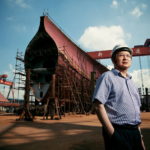Maritime China remains dominated by government-linked businesses, even as the overall cluster grows, reports Patrick Lee
Ten years after the global financial crisis, China continues to grow as a maritime power. For all the growth in[ds_preview] the presence of foreign shipping businesses, China’s maritime sector remains dominated by state-owned enterprises (SOEs), notably China COSCO Shipping Corporation (COSCOCS).
COSCOCS’ rise as the world’s largest ship owner symbolizes not only China’s growth as a maritime power, but also the government’s major involvement in shipping. Currently, the state-owned shipping enterprise owns a fleet of nearly 50mill. GT, including 9mill. GT under construction. Comprising eight subsidiaries, China COSCO Shipping Corporation was formed in 2016 after Beijing approved the merger between former rivals China Ocean Shipping and China Shipping Group.
The government has been engineering mergers between SOEs across various industries, seeking to re-establish larger state-owned businesses that could survive in difficult conditions and compete globally. Further consolidation continued in 2017 as COSCO, with fellow state-owned entity Shanghai International Port Group, announced a 6.3 bn $ acquisition of Orient Overseas International.
Besides box ships, COSCO is active in bulk carriers, oil tankers, LPG carriers and LNG carriers. The dry bulk unit has a fleet of more than 400 vessels. With the government also being heavily involved in steel manufacturing, it is not surprising that COSCO Shipping Bulk has dedicated contracts with state-owned steel producers, such as Baowu Steel Group and Ansteel.
Ship owning aside, the group’s influence can be felt worldwide, due to China’s Belt and Road initiative. COSCO owns ports and terminals throughout its native China, as well as in Italy, Greece, Spain, Belgium, the UAE, the Netherlands and Singapore.
The group’s various subsidiaries, such as COSCO Shipping Heavy Industry, COSCO Logistics and China International Marine Containers (CIMC) are respectively active in shipbuilding, ship agency and container manufacturing, among others. Under Xu Lirong, the group will keep investing in logistics infrastructure to better manage its supply chain, as the chairman revealed recently.
The second largest shipping group, the state-owned China Merchants Energy Shipping (CMES), has also undergone consolidation, after acquiring Sinotrans, another SOE, in 2017. Part of the group that was established in imperial China and set up the country’s first merchant fleet in 1872, CMES is today focused on energy shipping.
Both COSCO and CMES maintain close ties with global oil suppliers as well as refiners like PetroChina. CMES is also active in dry bulk shipping. CMES’s current total tonnage stands at over 15mill. GT, with tankers accounting for over 8mill. GT and bulk carriers accounting for over 7mill. GT.
Independent owners
Despite the dominance of COSCO and CMES, China has a good number of privately run ship owners. Several of these players are themselves involved in coal trading, and have invested in ships to support their operations.
Dongguan Huihuang Energy, one of China’s largest coal importers, concurrently acquired a fleet of bulk carriers that are allocated to its shipping subsidiary, Dongguan Haichang Shipping. The group owns 14 bulk carriers that are primarily secondhand purchases.
The Amoysailing group, another privately run ship owner, owns seven bulk carriers, while functioning as a charter operator under the name of Transpower-prefixed entities.
The Amoysailing group fixes out its own tonnage to third-party operators on period terms, while the Transpower entities charter in vessels from other owners to service its cargo book. The group transports Indonesian coal and grains to China, and ships steel products from China to South East Asia.
Chinese charter operators tend to be incorporated in Hong Kong, Singapore, Seychelles, British Virgin Islands and the Marshall Islands, while maintaining physical offices in China. This is because of restrictions on U.S. dollar remittances from Chinese banks.
The collapse of the dry bulk market in 2016 and the consequent depression in asset values also saw the appearance of opportunistic investors who acquired ships at low prices. Several of these investors incorporated individual special purpose vehicles in Hong Kong and the British Virgin Islands to own vessels, rather than setting up a holding company. Their low profile and lack of transparency led to them being termed »the unknown Chinese owner«.
One such company is the BVI-incorporated Crowne Century, which operates from Qingdao and controls three post-Panamax bulk carriers and one wood chips carrier through three SPVs. This company is said to be controlled by Yang Zhenxing, a Chinese national. When contacted, a company employee declined to elaborate on Crowne Century’s background, although HANSA was informed that Yang is a shipping investor.
Chinese Leasing still growing
Apart from traditional ship owners, the unabated growth of Chinese leasing companies has resulted in government-linked banks and even shipbuilders becoming major ship owners themselves. Chinese financial lessors’ business model is to either purchase ships from lessees and lease the units back to them, or finance newbuilding orders through bareboat charters to the ship operators. While these leasing companies are ultimately state-owned, they have seized opportunities left in the wake of reduced availability of bank finance for shipping.
Bank of Communications, through its leasing unit Bocomm, is now the largest non-operating Chinese ship owner, with around 110 in-service vessels in its portfolio. In similar fashion, its counterpart at the Industrial and Commercial Bank of China, ICBCFL, has been building up its portfolio, with a focus on cargo clients.
Speaking to HANSA, ICBCFL’s executive director Bill Guo said that this is a win-win position for the lessor: »In the case of our partnership with Vale, the miner enjoys competitive shipping costs, while we reduce our risks because the likelihood of a default is low.«
State power in shipbuilding
Shipbuilding remains dominated by SOEs, led by two conglomerates, China Shipbuilding Industry Corporation (CSIC) and China State Shipbuilding Corporation (CSSC), which respectively, have annual shipbuilding capacities of 15mill. dwt and 14mill. dwt. In comparison, the other state-owned shipbuilding group, Cosco Shipping Heavy Industry, has respective annual production capacity of 10.6mill. dwt. CSIC’s member yards are in the west and north of China, while yards under CSSC’s direction are in the east and south of the country.
While there has been speculation that CSIC could merge with CSSC, there has been no official confirmation, although trading of the stocks of both conglomerates’ publicly listed units has been suspended since 2017. A CSIC-CSSC union would create a shipbuilding behemoth, eclipsing South Korea’s Hyundai Heavy Industries.
The many shipyards that opened during the shipping boom of the late 20th century have closed, as the government enforced consolidation following the global financial crisis. In September 2014, a white list of shipyards was introduced. Yards on this list meet the Ministry of Industry and Information’s technical standards and will get preferential treatment in terms of financing and state grants. The list helped to remove 10mill. dwt of shipbuilding capacity, or 12.5% of China’s peak shipbuilding capacity.
However, Yangzijiang Shipbuilding has emerged as the most successful non-state-owned Chinese shipbuilder, with the most orders among all Chinese shipyards.
Its executive chairman, Ren Yuanlin, said: »To achieve sustainable growth, we will continue to upgrade our product portfolio, especially through improving the technological content and efficiencies of large-size containerships and dry bulkers. We are making good progress on the R&D and innovation in clean energy vessels and gradually building up the capabilities in building LNG and LPG related vessels. As cost of steel increased, we have implemented methods to improve the steel utilization rate, along with broad scale cost-cutting measures.«
Patrick Lee





















